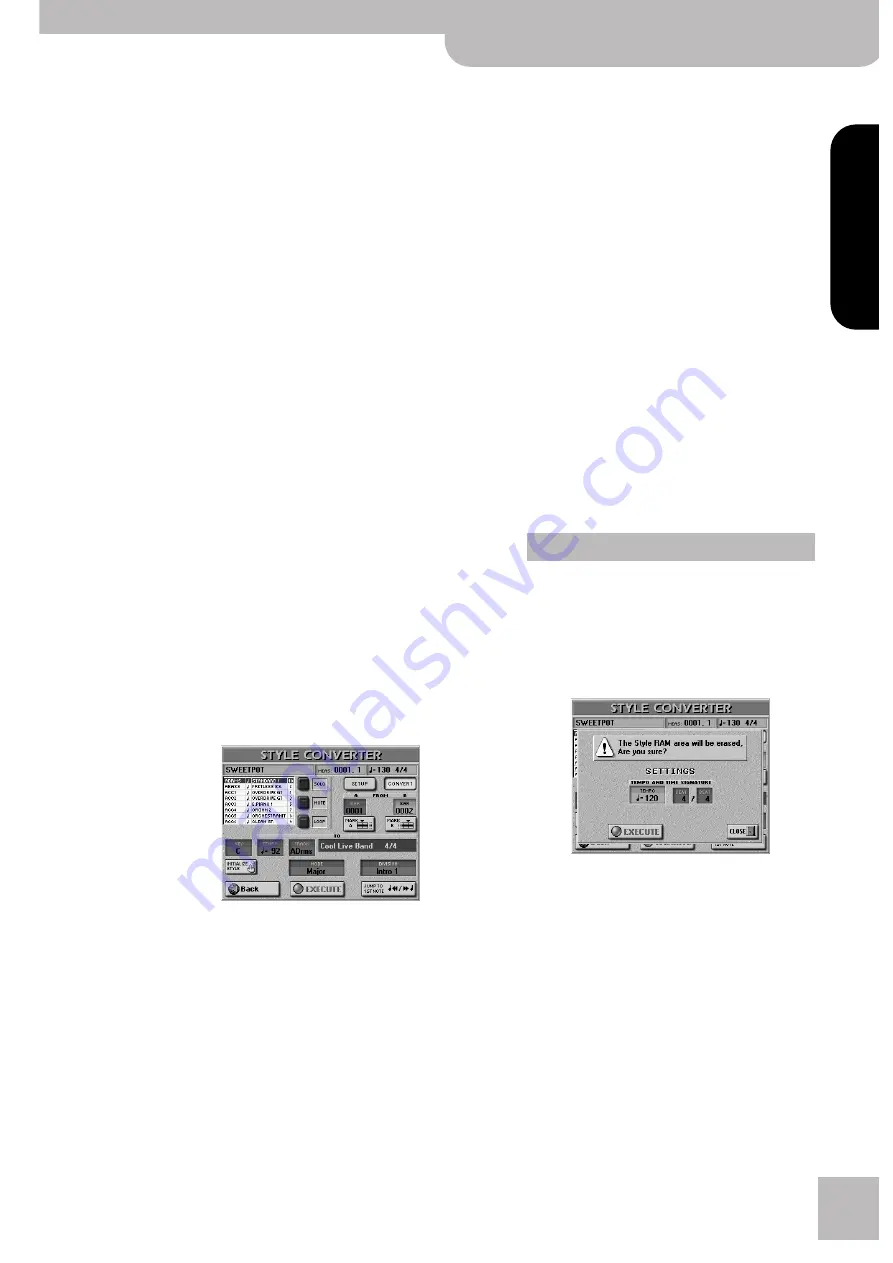
OS Version 2
G-70 Music Workstation
r
9
ENGLISH
ENGLISH
ENGLISH
ENGLISH
Note:
If you assign several song tracks to the same Style track,
a bullet (“
●
”) appears next to the Style track name in the table
to indicate that the Style track in question is already assigned
to another song track. (Though this is perfectly possible, the
result is usually not convincing.)
If necessary, press the
[INIT¥VALUE]
field to return to
the default assignments if that produces the best
result after all.
Auditioning the tracks
Press the
[Jump≈to≈1st≈note]
field to jump to the first
note of the selected song track (the one that appears
on a blue background). Playback starts automatically
from that point and you will hear all song tracks.
Press the RECORDER
[PLAY÷STOP¥®÷ª]
button to stop
playback (or to start it again).
Note:
If the selected track contains no data at all, playback is
started from the very first song measure.
■
Muting tracks
Sometimes, it may be necessary to mute certain parts
so as to concentrate on what the other tracks do, and
to decide which tracks should be converted into a
Music Style. To do so, press the
[MUTE]
field and then
the lines of the song tracks you don’t want to hear.
Such tracks are flagged with an “M”.
Press the
[MUTE]
field again to switch off the func-
tion of the same name.
■
Solo
To listen to one track in isolation, press the
[SOLO]
field and the field of the track you want to solo, then
start playback. This mutes all other tracks, while the
selected track is flagged with an “S”.
Press the
[SOLO]
field again to switch off the func-
tion of the same name.
(6) Press the
[CONVERT]
field to jump to the following
page.
Here, you can listen to the selected tracks, specify
which excerpt should be extracted and set the pat-
terns that should contain the selected data. The most
logical order for proceeding is as follows:
(7) Press the RECORDER
[TOP¥|√]
button, followed by
[PLAY÷STOP¥®÷ª]
to start song playback.
[FWD]
and
[BWD]
are also available for rewinding and
fast-forwarding.
(8) While listening to the song, press the
[MARK¥A]
field at the beginning of first measure to be con-
verted, and
[MARK¥B]
when the G-70 reaches the
last measure you need.
Alternatively, you can stop playback, press the FROM
[A]
or
[B]
“display” field and enter the measure num-
ber with the
[DATA÷ENTRY]
dial or the
[DEC]
/
[INC]
buttons.
(9) Stop playback by pressing
[PLAY÷STOP¥®÷ª]
.
(10) Switch on the
[LOOP]
button icon.
This function allows you to listen to the selected
excerpt (between
[A]
and
[B]
) repeatedly.
That way, you can check whether the last notes of
your pattern-to-be allow for a smooth transition to
other Music Style patterns, or sound natural when
the pattern is repeated. Sometimes, quantizing the
last few notes of an excerpt may be helpful to avoid
including notes that were played a little ahead of the
beat (and therefore sound on the last beat you con-
vert).
(11) Press the RECORDER
[PLAY÷STOP¥®÷ª]
button to
start playback.
The selected passage is repeated over and over until
you stop playback.
(12) If necessary, use the
[MUTE]
and
[SOLO]
fields to
temporarily switch off or isolate certain tracks.
This is only for checking purposes. The on/off status
does not affect the selection that will be converted.
The
[INITIALIZE¥STYLE]
field on this page is usually
used only once: before converting the first song
tracks. If you don’t use this field, the tracks you con-
vert are added to the Style data already present in
the G-70’s Style RAM area. If you need to start from
scratch, however (to create an entirely new Style)…
• Press the
[INITIALIZE¥STYLE]
field.
• Press the
[TEMPO]
and use the
[DATA÷ENTRY]
dial or
the
[DEC]
/
[INC]
buttons to enter the desired value.
• Press the two TIME SIGNATURE fields (one after the
other) and use the
[DATA÷ENTRY]
dial or the
[DEC]
/
[INC]
buttons to enter the desired value.
Note:
This is your first and last chance to specify the new
Style’s time signature. The only way you can do this is by ini-
tializing the Style RAM area. So be sure to set this value before
your very first conversion. (The Style’s time signature can also
be changed using the Style Composer, however, but that forces
you to change modes.)
• After setting everything to your liking, press the
[EXECUTE]
field to initialize the Style RAM area.
(Press
[CLOSE]
to leave this page without initializing
the data in RAM.)
Initializing the Style RAM memory
All manuals and user guides at all-guides.com
























